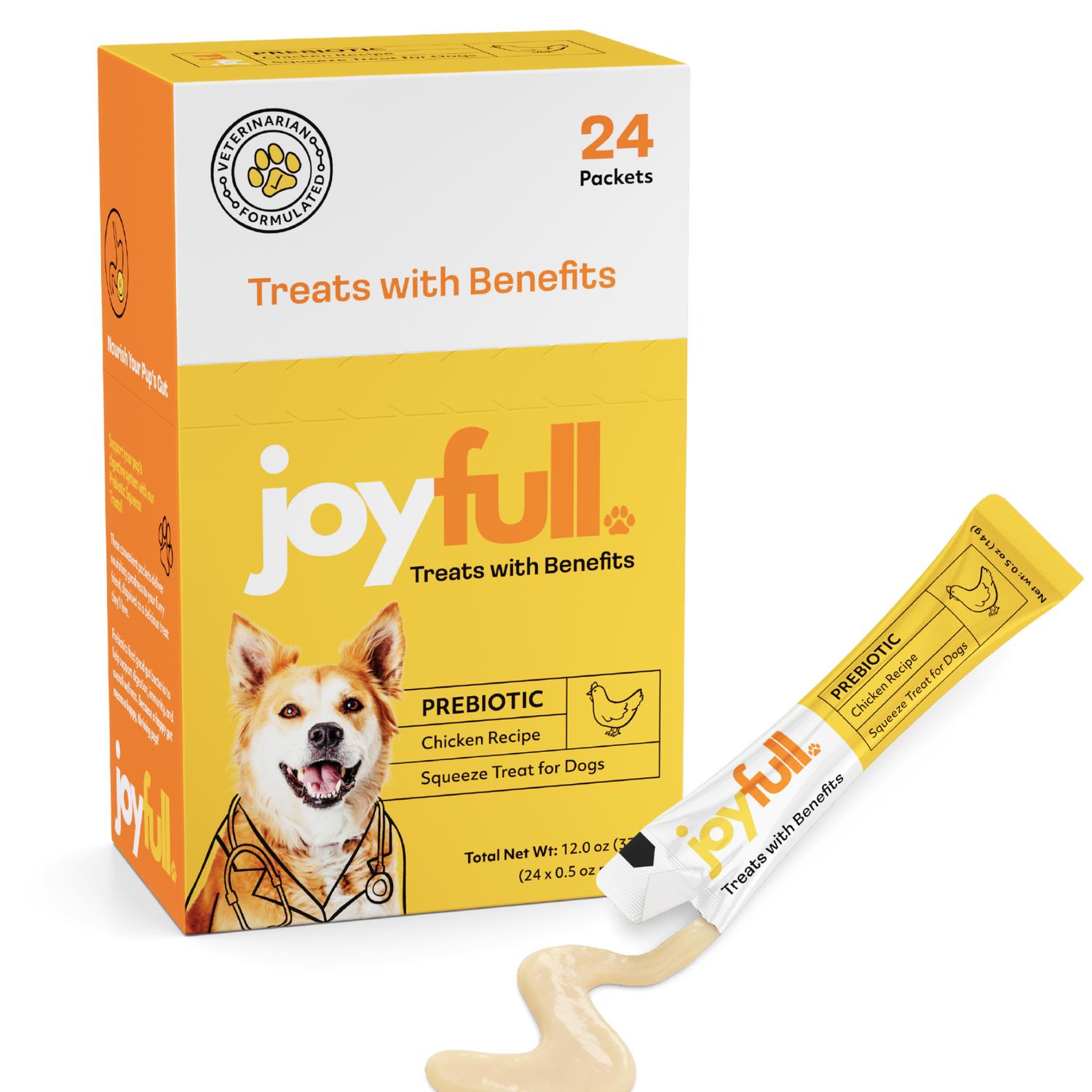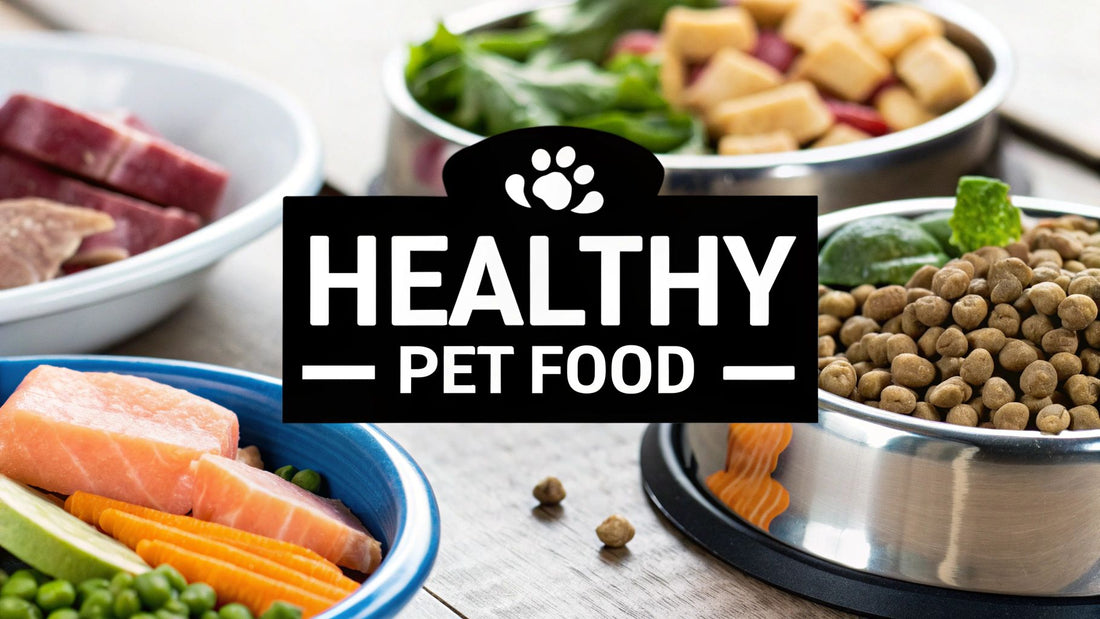
Top Healthy Pet Food Brands for Your Pet's Wellbeing
Navigating the pet food aisle can feel overwhelming, with countless brands all claiming to be the healthiest choice. So, how do you cut through the noise? The secret is hiding in plain sight: on the ingredient label. The first five ingredients listed tell you almost everything you need to know, revealing whether the food is built on high-quality protein or just cheap fillers.
Frankly, learning to decode that list is the most powerful skill you can have as a pet owner.
How to Read a Pet Food Label Like an Expert
Let's be real—pet food labels can seem like they're written in a completely different language. They’re a maze of technical terms, percentages, and clever marketing phrases. But here’s the good news: you don’t need a degree in animal nutrition to figure out what’s truly good for your pet.
Think of the ingredient list as the food's entire recipe, laid out for you to see. By law, ingredients are listed in descending order by weight, from heaviest to lightest. This simple rule means the first few ingredients make up the vast majority of what's in the bag. That’s why your focus should always be on the first five ingredients. They tell the true story of the food’s nutritional foundation.
The Power of the First Five Ingredients
When you scan that list, your eyes should hunt for specific, named sources of animal protein. Seeing terms like "deboned chicken," "grass-fed lamb," or "wild-caught salmon" right at the top is a fantastic sign. These are the high-quality building blocks your pet’s body is designed to thrive on, fueling everything from muscle development to a healthy coat.
On the flip side, vague and generic terms are a major red flag. Phrases like "meat and bone meal" or "poultry by-product meal" are deliberately ambiguous for a reason. They often contain a rendered mix of low-quality materials that are far less digestible and offer minimal nutritional value. The best pet food brands are transparent and proud to name their protein sources.
This is all about connecting the dots between quality ingredients, brand trust, and your pet's specific needs.
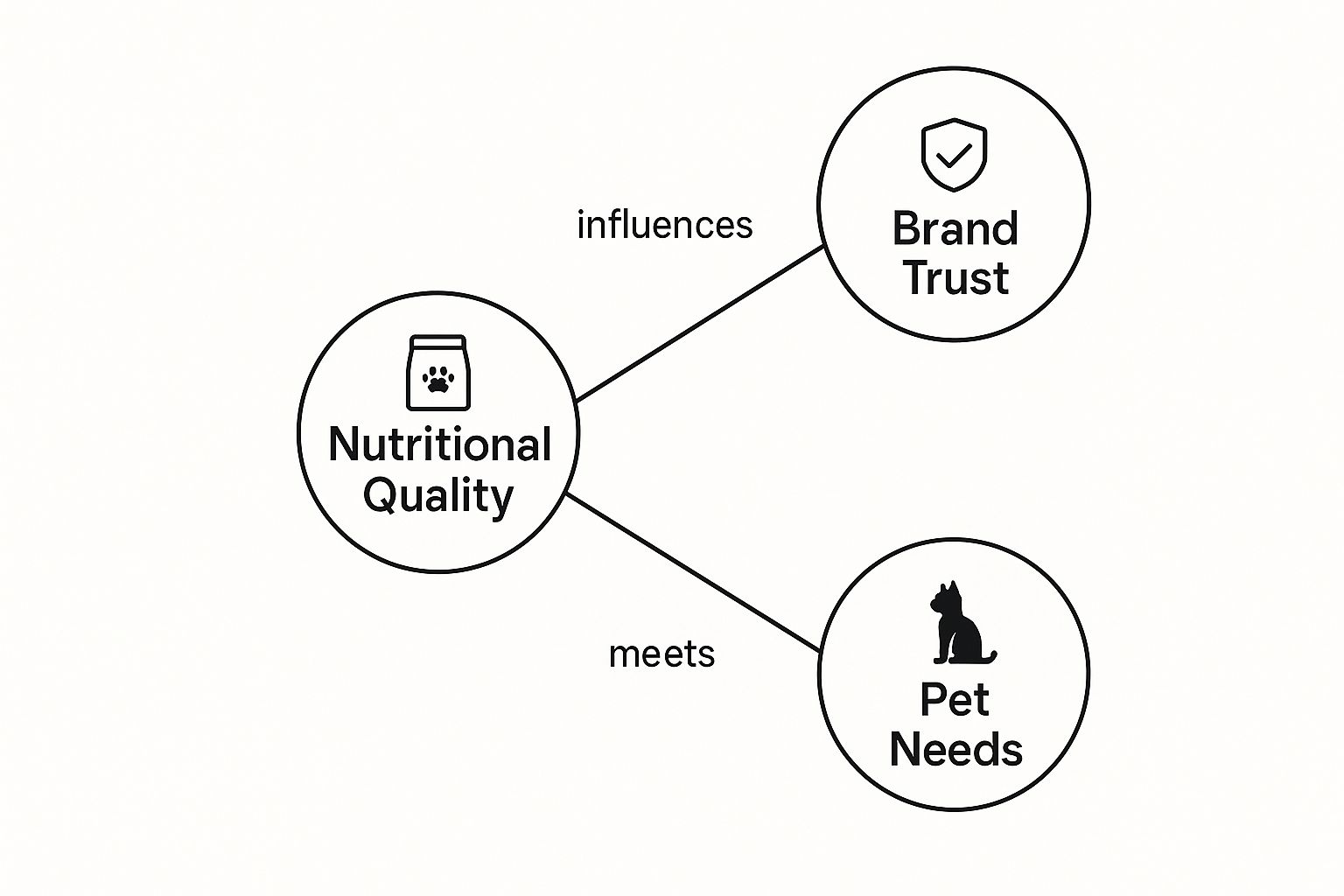
As the image shows, a brand’s commitment to quality ingredients is what builds the trust you need to properly care for your pet.
Decoding Common Label Terms
Beyond the top five, you'll see a lot of buzzwords that brands use to catch your eye. It's important to know that many of these terms aren't strictly regulated, so their meaning can be a bit fuzzy.
Spotting the difference between a real ingredient and a cheap filler is the core skill here. A named protein like 'turkey' is a world away from a generic term like 'meat by-products,' which can legally include some less-than-desirable parts of an animal.
Here are a few common phrases and what they really mean:
- Natural: This usually just means the food is free from artificial colors, flavors, or preservatives. It’s a good start, but "natural" says nothing about the quality of the core ingredients themselves.
- Holistic: This one has no legal definition in the pet food world at all. It's purely a marketing term used to suggest a focus on whole-body health, but it isn't backed by any regulatory standard. Use caution.
- Human-Grade: Now this is a term with some weight behind it. It means the ingredients are technically fit for human consumption, which signals that the food was made under much stricter safety and sourcing protocols. It’s a strong indicator of quality.
To make things even easier, here's a quick cheat sheet to help you tell the good stuff from the junk at a glance.
Quick Guide to Spotting Quality Ingredients
This simple table breaks down what to look for on a label versus what to avoid.
| What to Look For (High-Quality) | What to Avoid (Low-Quality & Fillers) |
|---|---|
| Specific, named animal proteins (e.g., chicken, beef, salmon, lamb) | Vague terms like "meat meal" or "animal by-products" |
| Whole vegetables and fruits (e.g., sweet potatoes, peas, blueberries) | Processed fillers like corn gluten meal, wheat gluten, or soy |
| Healthy fats from named sources (e.g., chicken fat, salmon oil) | Unidentified fats like "animal fat" |
| Whole grains (e.g., brown rice, oatmeal) if the food is not grain-free | Artificial preservatives (BHA, BHT, ethoxyquin), colors, and flavors |
| Clear, identifiable ingredients you recognize | Ambiguous ingredients or chemical-sounding names |
Remember, a quality ingredient list reads like a recipe you’d be proud to make yourself. For an even more in-depth look, check out our guide on how to read dog food labels.
By focusing on the first five ingredients and learning these key terms, you can confidently look past the flashy packaging and choose a food that will genuinely nourish your furry family member.
The Building Blocks of Your Pet's Health
If you want to find the best healthy pet food, you first have to know what "healthy" really looks like on an ingredient label. Think of your pet's diet like the foundation of a house. A solid, well-poured foundation means the house stands strong for decades. The same goes for your pet's health, and the core building blocks are the same big three you've heard of before: protein, fats, and carbohydrates.
Just like you can’t build a strong house with shoddy materials, your pet’s body needs high-quality nutrients to build everything from muscles and organs to a resilient immune system. Let's break down what that actually means.
Protein: The Bricks and Mortar
Protein is, without a doubt, the single most important nutrient in your pet's food. It’s the very stuff of life, responsible for building and repairing tissues, creating crucial enzymes and hormones, and fueling a strong immune response. For dogs, and especially for cats (who are obligate carnivores), animal-based protein isn't just a good idea—it's non-negotiable.
Imagine you're building a sturdy brick wall. You'd want strong, perfectly formed bricks. In pet food, the best "bricks" are named, whole animal proteins—think ingredients like "deboned chicken," "grass-fed beef," or "wild-caught salmon." These are top-tier, easily digestible, and packed with the complete set of amino acids your pet needs to thrive.
Now, picture someone handing you a bucket of crumbly, mismatched brick fragments. That’s the nutritional equivalent of vague ingredients like "meat and bone meal" or "poultry by-products." These are low-quality sources that are harder to digest and offer a much weaker nutritional punch. A truly healthy pet food brand will always build its recipes on a cornerstone of specific, high-quality proteins.
A pet's body is hardwired to run on animal protein. Cats, for example, need up to five times more protein in their diet than dogs do. That makes choosing a food with superior protein sources absolutely critical for their long-term wellness.
For a deeper dive into decoding these labels, check out our guide on what to look for in dog food. It’s the kind of knowledge that helps you see past the marketing hype and focus on what really builds health.
Fats: The Insulation and Wiring
If protein is the structure, then healthy fats are the home's essential systems—the insulation, the wiring, the plumbing. Far from being a dietary bad guy, fat is a powerhouse source of energy and is absolutely vital for countless bodily functions.
The real stars here are the essential fatty acids, like Omega-3 and Omega-6. They play a huge role in:
- Brain Health: Supporting sharp cognitive function and healthy development.
- Skin and Coat: Giving your pet that lustrous, shiny coat and keeping their skin healthy—which is their first line of defense against irritants.
- Reducing Inflammation: Helping to manage joint health and cool down inflammatory responses throughout the body.
On the ingredient list, you want to see named fat sources like "chicken fat" or "salmon oil." These are clear signs of quality. Vague terms like "animal fat" are a major red flag because you have no way of knowing the source or how good it is.
Carbohydrates: The Smart Energy Source
Finally, let's talk carbs. In our house analogy, carbohydrates are the power grid. But as we all know, not all power sources are created equal. You could have clean, efficient solar panels or a sputtering, unreliable generator.
- Beneficial Complex Carbs: These are the solar panels. Ingredients like sweet potatoes, peas, and whole oats are digested slowly, providing a steady stream of sustained energy. They also bring valuable fiber to the table, which is fantastic for digestive health.
- Cheap Fillers: These are the faulty generators. Ingredients like corn gluten meal, wheat gluten, and soy are often just cheap fillers used to bulk up a food and inflate the protein percentage on paper, without offering much species-appropriate nutrition.
While our pets don't have a strict biological requirement for a diet high in carbohydrates, the right kinds in the right amounts can absolutely support an active, happy life. The trick is learning to spot the difference between nutrient-dense carbs and the cheap, empty fillers that offer little more than calories. A premium brand always invests in the good stuff.
Walk down any pet food aisle, and you're bound to be hit with a dizzying array of terms: "grain-free," "organic," "human-grade." These labels almost always come with a higher price tag, which naturally makes you wonder—is this just clever marketing, or am I actually buying something better for my pet? Getting to the bottom of what these terms really mean is the key to deciding if they're a worthy investment for your four-legged family member.
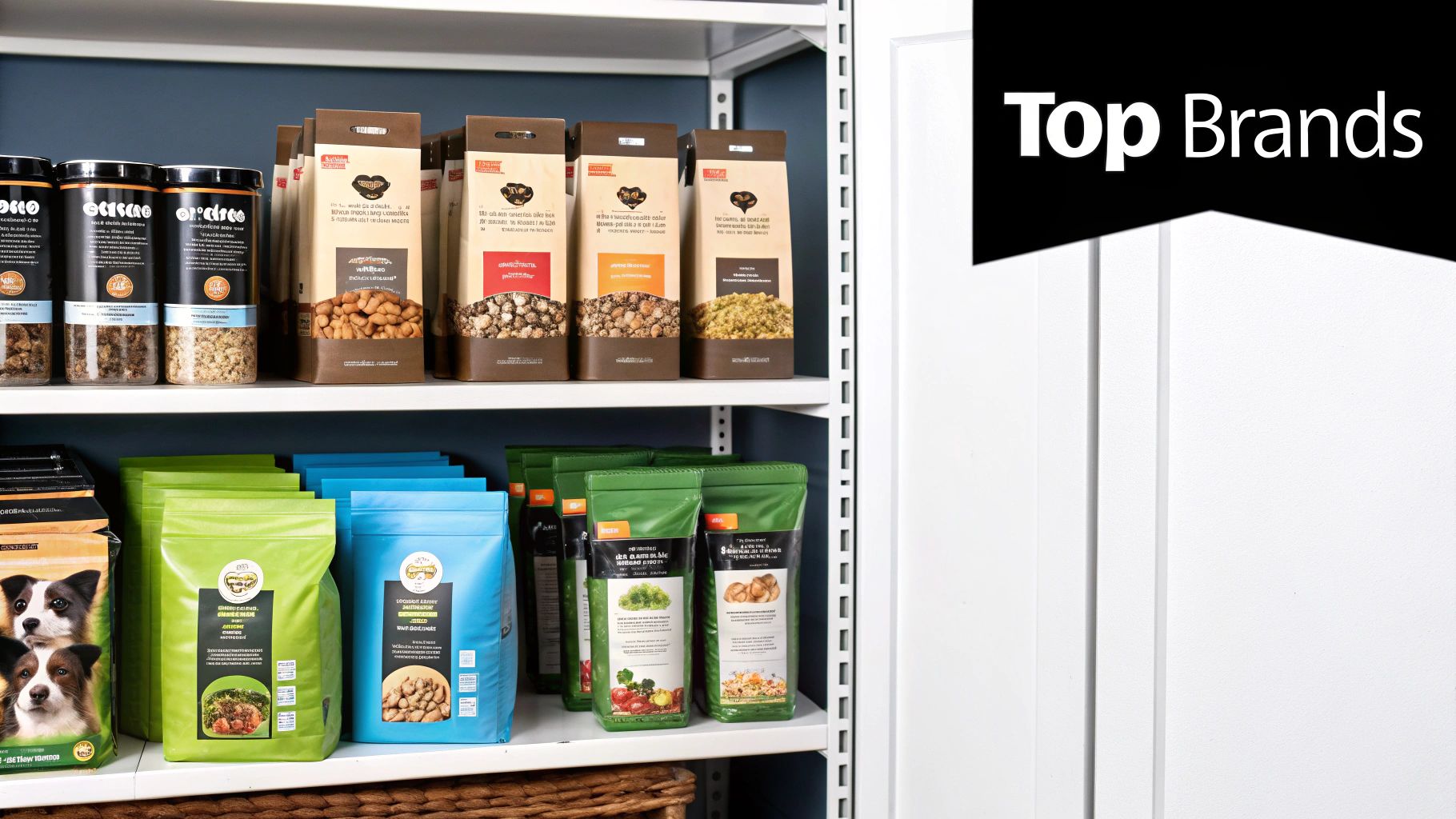
This focus on premium options reflects a massive shift in how we think about pet nutrition. The global pet food market, valued at roughly USD 128.21 billion, is expected to climb to an incredible USD 185.54 billion by 2030. It’s a trend largely driven by pet owners in North America, who make up about 40.6% of that market and are demanding higher-quality, clean-label foods. For a closer look at what's fueling this growth, you can check out the full report on pet food market trends.
The Grain-Free Food Debate
Of all the buzzwords, "grain-free" has probably sparked the most discussion—and confusion. For a long time, it was hailed as the pinnacle of healthy pet food. The logic seemed sound: our pets' wild ancestors didn't eat grains, so why should our modern pets?
There's some truth to that. Many grain-free foods do a great job of replacing low-value fillers like corn and wheat with more nutritious carbs, such as sweet potatoes, lentils, and peas. This can be a game-changer for pets with a diagnosed grain allergy or sensitivity, offering them energy sources that are much easier on their system.
However, "grain-free" doesn't automatically mean "better" for every pet. What really matters is what the grains are replaced with. A thoughtfully formulated food that includes healthy whole grains like brown rice or oatmeal can easily be more nutritious than a poorly designed grain-free diet packed with potato starch. At the end of the day, the quality of the protein and fat sources is what counts most.
The bottom line is this: "grain-free" is a specific solution for specific dietary problems, not a blanket stamp of quality. It's far more important to look at the overall ingredient list and how your individual pet responds to the food.
What Organic Really Means
Unlike many other labels, "organic" is legally protected and has a very specific definition. For a pet food to display the USDA Organic seal, it must meet strict standards that govern the entire process, from farm to bag.
Think of it as a commitment to a complete, natural ecosystem. To be certified organic, a food must meet these criteria:
- No Synthetic Pesticides or Fertilizers: The crops are grown in soil free from artificial chemicals, which is better for the planet and minimizes potential residues in your pet's bowl.
- No GMOs: Genetically modified organisms are completely off-limits in any ingredient labeled organic.
- Ethical Animal Care: The animals used for protein must have access to the outdoors, be fed organic feed, and never be given routine antibiotics or growth hormones.
When you choose organic, you're not just buying food; you're supporting a particular standard of farming and production. For many owners, it’s about the peace of mind that comes from avoiding unwanted chemicals and backing more sustainable agriculture.
The Human-Grade Standard
Out of all the premium labels, "human-grade" might just be the most significant in terms of quality and safety. This isn't just a fancy marketing term—it's a regulated standard that means every single ingredient, as well as the facility it was made in, is fit for people to eat.
To put it in perspective, think about the difference between a commercial kitchen in a high-end restaurant and a standard industrial processing plant.
- Human-Grade: Ingredients come from the same supply chain as food for grocery stores and restaurants. The food itself is made in facilities that must meet the FDA's strict safety and sanitation standards for human food.
- Feed-Grade: This is the standard for most conventional pet foods. These ingredients are held to a lower regulatory standard and can include materials not considered safe or appealing for human consumption, like certain animal by-products.
Opting for a human-grade food means you're getting a product with exceptional ingredient traceability and safety oversight. It’s about as close as you can get to cooking a fresh, whole-food meal for your pet in your own kitchen.
Why AAFCO Feeding Trials Are the Gold Standard
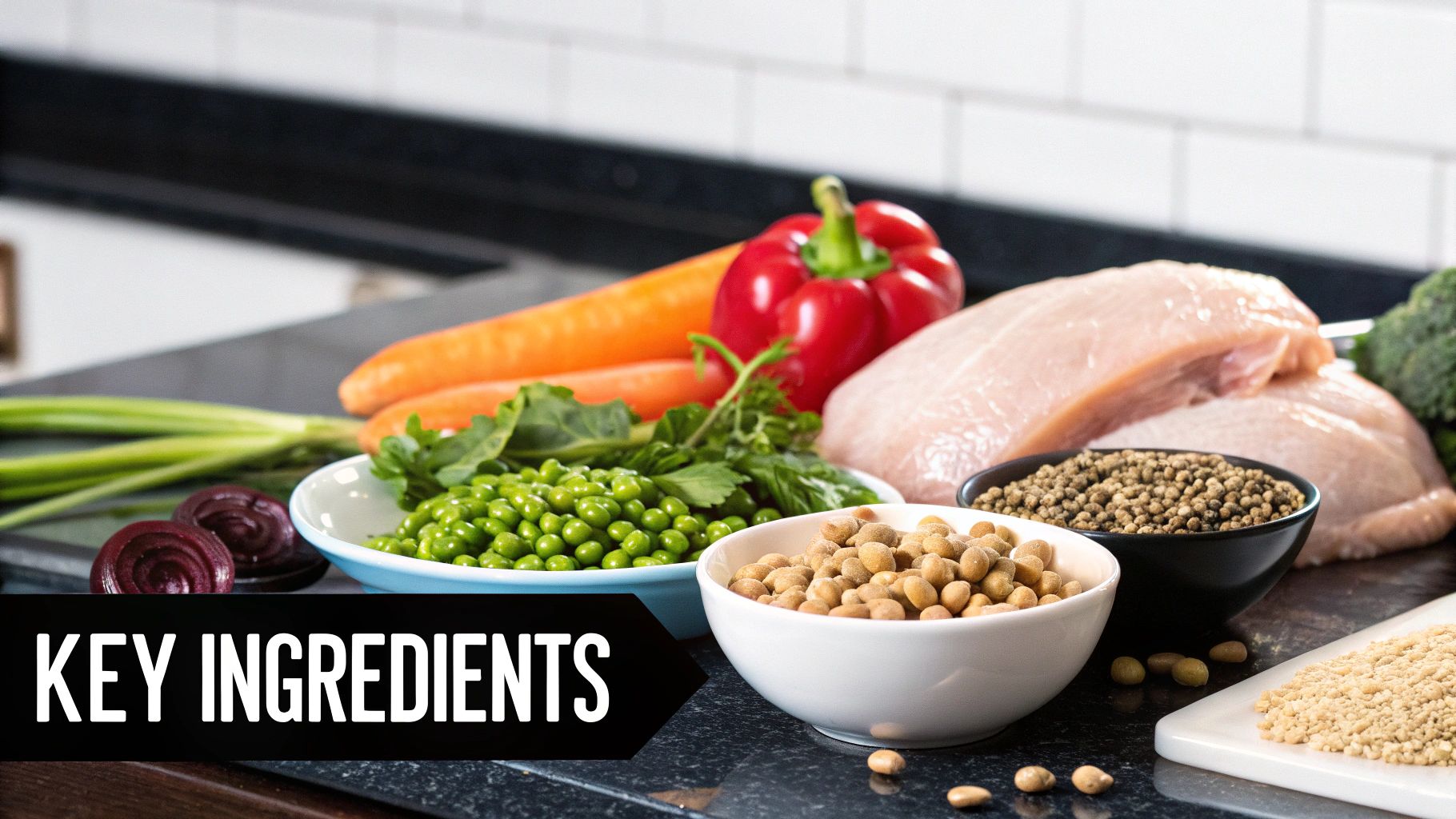
When you’re staring at a wall of pet food bags, the marketing claims can all start to blur together. How do you know if a brand's promise of "complete and balanced" nutrition is actually true? This is where a small, often overlooked statement on the back of the bag becomes your most powerful tool, thanks to the Association of American Feed Control Officials (AAFCO).
Now, AAFCO doesn't actually approve or regulate pet food. Instead, it sets the science-backed nutritional standards that reputable companies strive to meet. Think of them as the organization that writes the rulebook for what a puppy, adult dog, or senior cat needs to thrive. Spotting an AAFCO statement on the label is your first checkpoint for nutritional quality.
But here’s the crucial part: not all AAFCO statements are created equal. They reveal two very different paths a brand can take to prove its worth, and as a pet owner, knowing the difference is everything.
Formulated vs. Feeding Trials
Look closely at the nutritional adequacy statement on any bag of food. You'll find one of two key phrases. Understanding them is like knowing the difference between a car's blueprint and the results of a real-world crash test.
-
Formulated to Meet AAFCO Standards: This means the food was designed on a computer or in a lab. The manufacturer followed a recipe that, on paper, meets all the minimum requirements for proteins, fats, vitamins, and minerals. It’s the blueprint—in theory, everything looks perfect.
-
Animal Feeding Trials: This is the crash test. It means the brand went the extra mile and actually fed that specific food to real dogs or cats for an extended period, typically six months, under strict AAFCO protocols. Veterinarians monitored the animals throughout the trial to make sure the food truly supported their health in the real world.
A food that has passed a feeding trial offers a much higher level of confidence. It proves not just that the right nutrients are in the bag, but that they are bioavailable—meaning your pet can actually absorb and use them to stay healthy long-term.
Think of it this way: a cake recipe might look flawless, with all the right ingredients listed. But you don't really know if it’s delicious and satisfying until people have actually eaten and enjoyed it. A feeding trial is the ultimate proof in the pudding, confirming a food’s performance goes way beyond theory.
Why It Matters for Your Pet
Choosing a food backed by AAFCO feeding trials gives you a powerful layer of assurance. It signals that a brand was willing to invest significant time and money to prove its product is safe and effective over the long haul.
While many great foods are "formulated," a feeding trial provides concrete evidence that the food performs as promised. For pets with sensitive systems, or for owners who simply want the highest level of certainty, looking for that statement is one of the smartest moves you can make. It shows a brand is willing to put its money where its mouth is, proving its formula works not just in a database, but in the bodies of pets just like yours. It’s called the gold standard for a reason.
Examples of Top Healthy Pet Food Brands
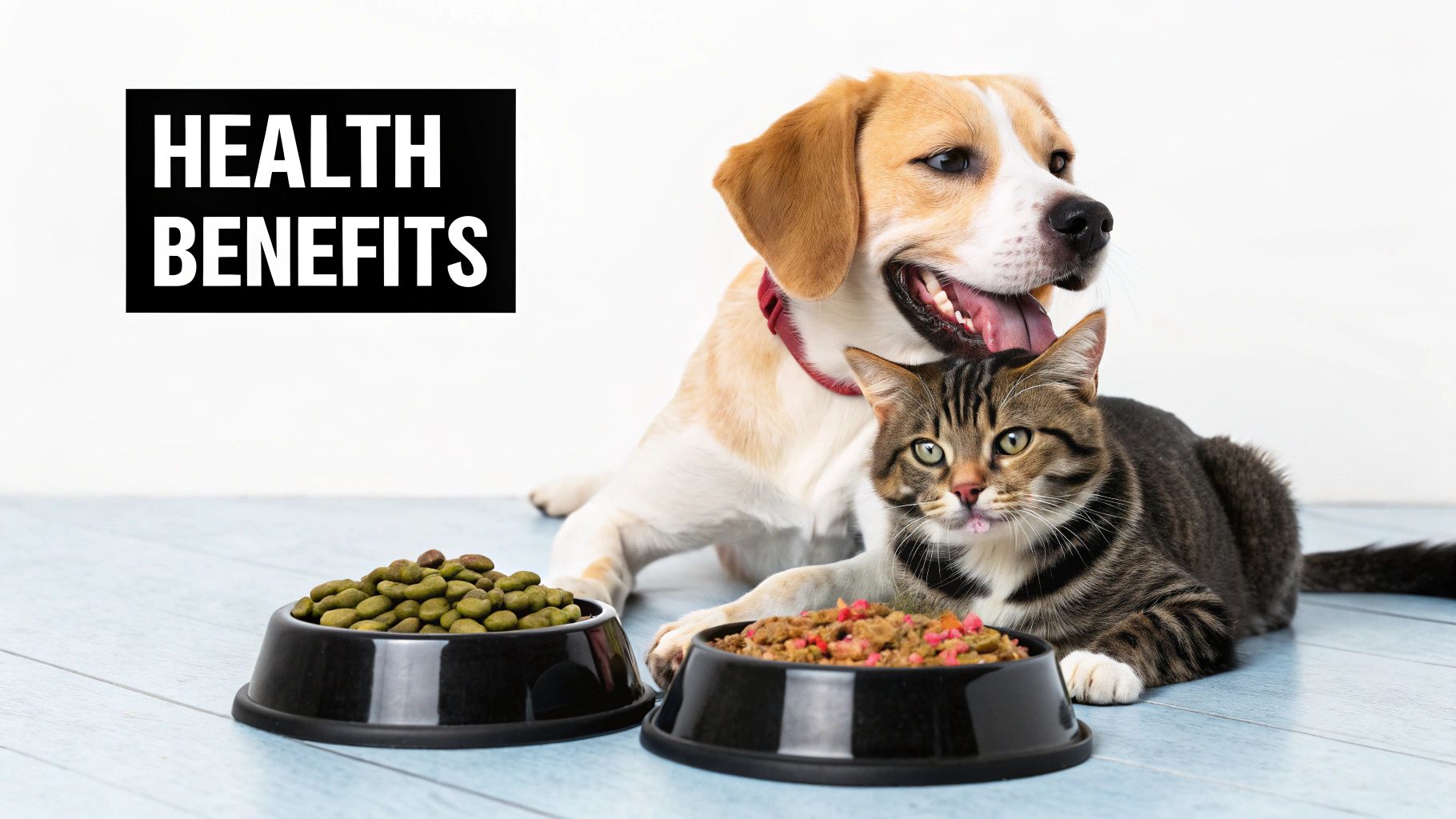
Okay, we’ve covered a lot of the theory behind what makes a pet food healthy. But what does that actually look like in the real world, on a store shelf or a brand's website? This is where we bridge the gap between reading labels and recognizing truly exceptional quality.
Let's look at a few examples of healthy pet food brands to see how different companies put these high standards into practice. This isn't about endorsements, but about understanding the why behind their reputation. We’ll examine their core philosophies and see how that thinking shapes the food that ends up in your pet's bowl.
This push for better nutrition is a huge deal. The global pet food market is currently valued at around USD 132.4 billion and is expected to climb to an astonishing USD 247.7 billion by 2035. What’s driving this? The "pet humanization" trend—we see our pets as family members and want their food to reflect that love. You can dive deeper into this industry shift by checking out the full market report.
The Human-Grade Pioneer
Some of the most talked-about brands have built their entire identity around one powerful principle: the human-grade standard. Their philosophy is refreshingly simple: if an ingredient isn't fit for human consumption, it has no business being in a pet's food bowl. This single commitment completely changes how they source ingredients and produce their food.
- Ingredient Philosophy: They pull 100% of their ingredients from the human food supply chain. That means no questionable feed-grade meats, rendered meals, or vague by-products.
- Manufacturing: Production takes place in FDA-inspected human food facilities, holding them to the same rigorous safety and sanitation rules as the food we eat.
- Standout Formulations: These brands often lean into gently cooked or dehydrated recipes. The goal is to maximize the bioavailability of nutrients, offering something of a middle ground between traditional kibble and a raw diet.
For pet parents who want the highest possible level of transparency and safety, this approach offers incredible peace of mind.
The Science-Backed Innovator
On the other end of the spectrum are brands that stake their reputation on deep nutritional science and veterinary research. Their mission is to craft targeted formulas designed to solve specific health problems, whether it's supporting aging joints or calming a sensitive stomach.
This philosophy is all about evidence-based nutrition, not just chasing trends like "grain-free." These companies typically have full-time veterinary nutritionists on staff and conduct extensive research, including formal AAFCO feeding trials, to prove their formulas work.
Their ingredient lists are carefully constructed with proven combinations of high-quality proteins, beneficial fibers, and targeted supplements like glucosamine or probiotics. This makes them one of the most reliable types of healthy pet food brands for any pet with specific health concerns.
The Limited Ingredient Specialist
For dogs and cats plagued by food sensitivities or allergies, simplicity is everything. This is where Limited Ingredient Diet (LID) brands shine. They focus on stripping recipes down to the absolute essentials to minimize the chance of triggering a reaction.
A typical LID formula is beautifully straightforward:
- Primary Protein: A single, often novel, protein source like duck, lamb, or rabbit.
- Carbohydrates: Usually just one or two easily digestible sources, like sweet potato or peas.
- No Common Allergens: These recipes are inherently free from the most common culprits like chicken, beef, dairy, and wheat.
By keeping the ingredient list short and clean, these brands give owners and veterinarians a powerful tool for managing dietary issues.
Healthy Pet Food Brands Feature Comparison
So, how do these different philosophies stack up against each other? The table below gives a quick snapshot, showing how each approach leads to a unique set of features.
| Brand Example | Key Philosophy | Primary Protein Sources | Notable Features |
|---|---|---|---|
| Human-Grade | Food safety and ingredient purity | USDA-inspected beef, chicken, turkey | Made in human-food kitchens; often fresh or dehydrated |
| Science-Backed | Evidence-based, targeted nutrition | High-quality chicken, salmon, lamb meal | Backed by feeding trials; formulas for specific health needs |
| Limited Ingredient | Allergen avoidance through simplicity | Novel proteins like duck, rabbit, lamb | Single protein source; ultra-short ingredient list |
As you can see, each of these paths leads to a high-quality product. The "best" choice really comes down to your individual pet. Do they need maximum safety, targeted health support, or help managing a sensitive stomach? By understanding these different approaches, you’re now ready to find a brand whose philosophy is the perfect match for your pet's wellness.
When we talk about what makes a pet food "healthy," the conversation is getting bigger. For a lot of us, it's not just about our pet's well-being anymore; it's about the health of our planet, too. This idea of sustainability has moved from the fringe to the forefront, becoming a real benchmark for the best healthy pet food brands.
So, what does sustainability actually look like in a bag of kibble or a can of wet food?
It All Starts at the Source
At its core, sustainability is about responsible sourcing. Think of it as the brand making a promise to the entire ecosystem, not just your pet. This means sourcing fish in ways that don't destroy ocean populations, choosing proteins from animals that were raised humanely, and buying ingredients from local farms whenever possible to cut down on transportation pollution.
It's really about knowing the story behind the food. True transparency means a brand can tell you exactly where every single ingredient came from and how it got from the farm to your pet's bowl.
Thinking Outside the Bag
A brand's commitment to the planet doesn't stop with the food itself. The packaging that holds the food is a huge piece of the puzzle. The most forward-thinking companies are actively moving away from those old-school, multi-layered bags that are destined for the landfill.
This push for greener practices isn't just a local trend. All across Europe, North America, and Asia, pet owners are letting their wallets do the talking. This demand for products that are good for both pets and the planet is forcing brands to get creative. You can see just how much sustainability is reshaping the industry in recent market reports.
Some of the packaging innovations you might see on the shelf include:
- Recyclable Bags: Many brands are switching to bags made from a single type of plastic (mono-material), which means they can actually be recycled. This is a big improvement over the old complex bags.
- Post-Consumer Recycled Materials: Some companies are making new bags out of old, recycled materials, which is a fantastic way to reduce waste and the need for new plastic.
- Plant-Based Plastics: You might even come across "bioplastics" made from things like corn or sugarcane, which are renewable and a really promising alternative.
When you choose a brand that's open and honest about its sustainability efforts, you’re doing more than just feeding your dog or cat. You're supporting a healthier planet and using your choice to reward companies that are serious about protecting our environment for the long haul. It's a powerful way to make sure your pet care choices line up with your personal values.
Common Questions About Choosing Healthy Pet Food
Even after you've learned to decode labels and understand industry standards, some practical questions always pop up. Let's tackle the common hurdles pet owners face when they’re standing in the pet food aisle, ready to make a change for the better.
Think of this as your final checklist—the last few bits of practical advice to help you feel confident about switching to a truly high-quality diet for your pet.
How Do I Safely Switch My Pet to a New Food?
The golden rule here is: go slow. Rushing a food transition is a recipe for an upset stomach. A gradual switch over 7-10 days gives your pet's digestive system time to adapt, making the whole process much smoother for everyone involved.
Start by mixing just a little of the new food (about 25%) with 75% of their old food. After two or three days, bump it up to a 50/50 mix. Continue increasing the new food and decreasing the old every couple of days until you've completely phased the old food out. Just keep an eye on your pet for any digestive weirdness and don't be afraid to slow the pace if needed.
Are Expensive Pet Food Brands Really Worth It?
It's a fair question. In many cases, yes, that higher price tag genuinely reflects superior ingredients and more rigorous quality control. While price isn't the only indicator of quality, premium brands are more likely to use named, whole-food proteins instead of vague "meat meals" or cheap fillers like corn and soy. This means more nutrition gets absorbed, and less of it passes through as waste.
I like to think of it as an investment in preventative care. Feeding a high-quality diet supports their health from the inside out, which can mean a happier pet and fewer unexpected vet visits down the line.
The real value is in the outcome. Better ingredients often lead to visible benefits like a shinier coat, more consistent energy levels, and improved digestion. Paying more upfront for a high-quality food can be more cost-effective over your pet's lifetime.
What Should I Look For if My Pet Has a Sensitive Stomach?
If your pet has a finicky digestive system, the best approach is often "less is more." You'll want to look for brands that offer Limited Ingredient Diets (LID). These formulas are specifically crafted to be gentle on the stomach by keeping the ingredient list short and simple.
An LID food is usually built around a few key principles:
- A single, novel protein source (like duck, venison, or lamb) that your pet likely hasn't been exposed to before.
- A limited number of simple, digestible carbohydrates like sweet potatoes or peas.
- No common allergens like chicken, beef, dairy, or wheat that are frequent culprits for sensitivities.
This minimalist approach makes it much easier to figure out what agrees with your pet. If you've noticed that food sensitivities are showing up as skin issues, our guide on the best dog food for skin allergies has some great insights. And, of course, always have a chat with your vet before making a big dietary change, especially for a pet with known health concerns.
At Joyfull, we believe that a healthful life isn’t just for humans—our pets deserve it, too. We create formulas with clean ingredients and high-quality proteins, all rigorously reviewed by our in-house veterinary advisor. Explore our commitment to pet wellness at https://joyfullpet.com.
